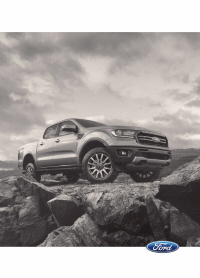This view of the Owner's Manual contains the very latest information, which may vary slightly from the printed Owner's Manual originally provided with your vehicle. It may also describe content that is not on or operates differently on your vehicle. Please consider the Owner's Manual originally provided with your vehicle as the primary source of information for your vehicle.

The information contained in this publication was correct at the time of release.In the interest of continuous development, we reserve the right to change specifications, design or equipment at any time without notice or obligation.No part of this publication may be reproduced, transmitted, stored in a retrieval system or translated into any language in any form by any means without our written permission.Errors and omissions excepted.
Copyright © 2024 Ford Motor Company
Normal Scheduled Maintenance
Intelligent Oil-Life Monitor™
Your vehicle has an Intelligent Oil-Life Monitor that determines when you should change the engine oil based on how you use your vehicle. By using several important factors in its calculations, the monitor helps reduce the cost of owning your vehicle and reduces environmental waste at the same time.
This means you do not have to remember to change the oil on a mileage-based schedule. Your vehicle lets you know when an oil change is due by displaying a message in the information display.
The following table provides examples of vehicle use and its impact on oil change intervals. It is a guideline only. Actual oil change intervals depend on several factors and generally decrease with severity of use.
| When to Expect the OIL CHANGE REQUIRED Message | |
|---|---|
| Interval1 | Vehicle Use and Example |
| 7,500–10,000 mi (12,000–16,000 km) | Normal |
| Normal commuting with highway driving No, or moderate, load or towing Flat to moderately hilly roads No extended idling | |
| 5,000–7,500 mi (8,000–12,000 km) | Severe |
| Moderate to heavy load or towing Mountainous or off-road conditions Extended idling Extended hot or cold operation | |
| 3,000–5,000 mi (5,000–8,000 km) | Extreme |
| Maximum load or towing Extreme hot or cold operation Extended engine idling | |
1Hybrid vehicles may achieve longer distances between oil changes, but do not exceed the 1 year maximum oil change interval. Remaining oil life can be accessed through the information display. See
Information Displays.
Normal Maintenance Intervals
| At Every Oil Change Interval as Indicated by the Information Display1 |
|---|
| Change the engine oil and filter. |
| Rotate the tires, inspect tire wear and measure the tread depth. |
| Perform a multi-point inspection, recommended. |
| Inspect the automatic transmission fluid level, if your vehicle has a dipstick. Consult your dealer for requirements. |
| Inspect the brake pads, shoes, rotors, drums, brake linings, hoses and the parking brake. |
| Inspect the engine cooling system strength and hoses. |
| Inspect the exhaust system and heat shields. |
| Inspect the front axle and U-joints. Lubricate if equipped with grease fittings. Four–wheel drive vehicles. |
| Inspect the half-shaft boots. |
| Inspect the steering linkage, ball joints, suspension, tire-rod ends, driveshaft and the U-joints. Lubricate any areas with grease fittings. |
| Inspect the wheels and related components for abnormal noise, wear, looseness or drag. |
1 Do not exceed one year or
10,000 mi (16,000 km) between service intervals.
| Brake Fluid Maintenance2 | |
|---|---|
| Every 3 Years | Change the brake fluid.3 |
2 Perform this maintenance item every 3 years. Do not exceed the designated time for the interval.
3Brake fluid servicing requires special equipment available at your authorized dealer.
| Other Maintenance Items 1 | |
|---|---|
| Every 20,000 mi (32,000 km) | Replace the cabin air filter. |
| Every 30,000 mi (48,000 km) | Replace the engine air filter. |
| Every 100,000 mi (160,000 km) | Replace the spark plugs. |
| Inspect the accessory drive belt or belts. 2 | |
| Every 150,000 mi (240,000 km) | Change the automatic transmission fluid and filter. |
| Change the front axle fluid. Four-wheel drive vehicles. | |
| Change the rear axle fluid. | |
| Change the transfer case fluid. Four-wheel drive vehicles. | |
| Replace the accessory drive belt or belts. | |
| At 200,000 mi (320,000 km) | Change the engine coolant. 3 |
1 Perform these maintenance items within
3,000 mi (4,800 km) of the last engine oil and filter change. Do not exceed the designated distance for the interval.
2 After initial inspection, inspect every other oil change until replaced.
3 Initial replacement at 10 years or
200,000 mi (320,000 km), then every five years or
100,000 mi (160,000 km).
Thank You For Your Feedback
